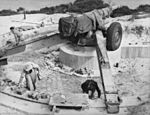Cockburn Sound
Bodies of water of the Indian OceanCockburn SoundUse Australian English from December 2013

Cockburn Sound (Nyungar Aboriginal Australian name: Derbal Nara) is an inlet of the Indian Ocean on the coast of Western Australia. It extends from the south of the mouth of the Swan River at Fremantle for about 25 km to Point Peron near Rockingham. The total area of the sound is about 100 km2. It is bounded on the east by the mainland council areas of Cockburn and Kwinana, on the west by Garden Island and Carnac Island, and includes several rocky outcrops and reefs. The Gage Roads shipping channel lies to the north. The sound was named in 1827 by Captain James Stirling, probably after Admiral Sir George Cockburn.The Perth Seawater Desalination Plant can be found here.
Excerpt from the Wikipedia article Cockburn Sound (License: CC BY-SA 3.0, Authors, Images).Cockburn Sound
City Of Cockburn
Geographical coordinates (GPS) Address Nearby Places Show on map
Geographical coordinates (GPS)
| Latitude | Longitude |
|---|---|
| N -32.166666666667 ° | E 115.71666666667 ° |
Address
City Of Cockburn
City Of Cockburn
Western Australia, Australia
Open on Google Maps









